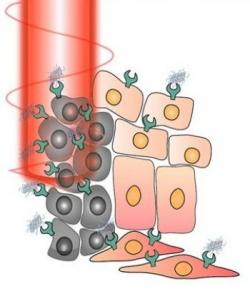Researchers from Korea developed a new skin cancer photothermal therapy using graphene oxide. The idea is to attach the GO particles to tumor cells, and then shine near-infrared laser light on them. The GO generate heat (and destroy the tumor cells) when exposed to the light, while healthy cells are not effected. Graphene is more efficient than gold for converting the light into heat, and it's also cheaper.

The researcher coupled the graphene with hyaluronic acid, a sugar polymer that is found naturally in skin and is an ingredient in skin care products. The polymer can penetrate the skin’s top layer, and tumor cells are known to express a large number of hyaluronic acid receptors on their surfaces. So this coupling allows the researchers to apply the graphene oxide particles to the skin, avoiding the need to inject them.
We have heard of several graphene-based cancer treatment in past years. Only a couple of months ago it was reported that graphene oxide is a possible localized hyperthermia agent that helps boost the cytotoxic effects of chemotherapy or radiotherapy and also increases the permeability of tumor cells to drugs. In that research graphene's near-infrared light conversion to heat was used.
Grafoid and ProScan Rx Pharma recently announced a new joint-venture partnership to develop MesoGraf graphene-based nanotechnology platform for the precise targeting and thermal eradication of solid cancer tumors. They established a new company called Calevia to handle this development.
Graphene Oxide can also be used as an anti-cancer drug carrier, and GO-based chips are being developed to enable biopsy-free early cancer diagnosis.